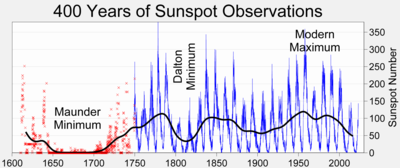A Dalton Minimum Repeat is Shaping Up
![latest[1]](http://wattsupwiththat.files.wordpress.com/2010/12/latest1.jpg?w=256&h=256) The sun went spotless yesterday, the first time in quite awhile. It seems like a good time to present this analysis from my friend David Archibald. For those not familiar with the Dalton Minimum, here’s some background info from Wiki:
The sun went spotless yesterday, the first time in quite awhile. It seems like a good time to present this analysis from my friend David Archibald. For those not familiar with the Dalton Minimum, here’s some background info from Wiki:The Dalton Minimum was a period of low solar activity, named after the English meteorologist John Dalton, lasting from about 1790 to 1830.[1] Like the Maunder Minimum and Spörer Minimum, the Dalton Minimum coincided with a period of lower-than-average global temperatures. The Oberlach Station in Germany, for example, experienced a 2.0°C decline over 20 years.[2] The Year Without a Summer, in 1816, also occurred during the Dalton Minimum. Solar cycles 5 and 6, as shown below, were greatly reduced in amplitude. – Anthony
Guest post by David Archibald
James Marusek emailed me to ask if I could update a particular graph. Now that it is a full two years since the month of solar minimum, this was a good opportunity to update a lot of graphs of solar activity.
 Figure 1: Solar Polar Magnetic Field Strength
Figure 1: Solar Polar Magnetic Field Strength
The Sun’s current low level of activity starts from the low level of solar polar magnetic field strength at the 23/24 minimum. This was half the level at the previous minimum, and Solar Cycle 24 is expected to be just under half the amplitude of Solar Cycle 23.
Continue reading
James Marusek emailed me to ask if I could update a particular graph. Now that it is a full two years since the month of solar minimum, this was a good opportunity to update a lot of graphs of solar activity.
 Figure 1: Solar Polar Magnetic Field Strength
Figure 1: Solar Polar Magnetic Field StrengthThe Sun’s current low level of activity starts from the low level of solar polar magnetic field strength at the 23/24 minimum. This was half the level at the previous minimum, and Solar Cycle 24 is expected to be just under half the amplitude of Solar Cycle 23.
Continue reading
George Monbiot probably burst a blood vessel when he read this. Congratulations to Piers, who doesn’t need a teraflop class supercomputer to render a forecast. This passage tells the story:
 Here’s some excerpts: Continue reading
Here’s some excerpts: Continue reading
I have not a clue whether his methods are sound or not. But when so many of his forecasts seem to come true, and when he seems to be so consistently ahead of the Met Office, I feel I want to know more.Maybe that’s why Mr. Johnson says London is prepared for snow, where others are not.
 Here’s some excerpts: Continue reading
Here’s some excerpts: Continue reading 
No comments:
Post a Comment
Note: only a member of this blog may post a comment.